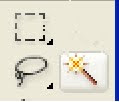src="http://pagead2.googlesyndication.com/pagead/show_ads.js">
Hello,
Today Harry told me that he wanted know how what are selection and modification tools in photoshop and how to use them. I told him what types of tools they are and where to use them. He got to very impressed that he wants to learn more. I explained him that photoshop provides three simple tools for selection: Marquee, Lasso and Magic Wand. They are located on he top of the toolbar. In addition, you can use commands on the Select menu.

The selection tools allow you to select a portion or a subset of an
image to work on. Most of Photoshop's other tools and filters can then be applied to this selected area, altering its color, shape, texture, position and/or other attributes, while leaving the rest of the image untouched.
 The Marquee Tools are used to select a specific regularly shaped area. The marquee tools include the Rectangular, Elliptical, Single Row and Single Column Marquees.
The Marquee Tools are used to select a specific regularly shaped area. The marquee tools include the Rectangular, Elliptical, Single Row and Single Column Marquees.
The Lasso Tools are used to select an irregular area. These tools include the Lasso Tool, the Polygonal Lasso Tool and the Magnetic Lasso Tool.
 The Magic Wand is used to select areas of an image based upon color. The Magic Wand does not have additional tools.
The Magic Wand is used to select areas of an image based upon color. The Magic Wand does not have additional tools.All of the selection tools may be used individually or in conjunction with each other to select exact areas of images. The Options Bar allows you to choose to add to or subtract from a previous selection.
If you choose New Selection, any currently active selection will go away.
If instead you would like to add to the current selection, or subtract from it, make that choice in the Options Bar. You can even choose to select an area formed by the intersection of your selections.
Thanks For Reading!!



















